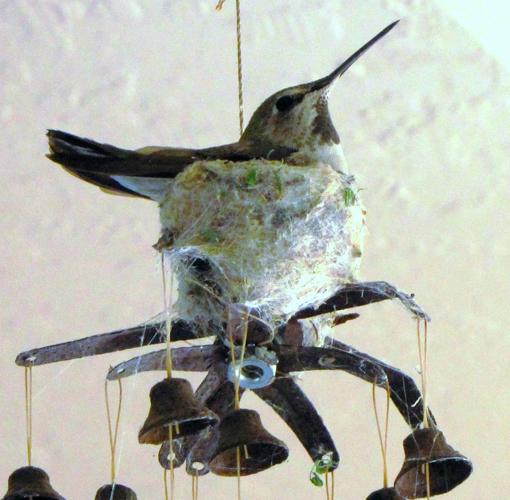With nine active sugar water feeders, we feed a lot of hummingbirds in our yard. We’ve recorded all seven of SaddleBrooke’s known species, including the only reported Calliope. We see plenty of females as well as males, and we see them early in the morning, throughout the day and at dusk. This range of observation times suggests hummingbirds are nesting in our yard, but we have never found a hummingbird nest on our own property. We do have a lot of trees, vines, bushes and other secretive spots where female hummingbirds could hide their nests, but you would think we could have found at least one in the 13 years we’ve lived here. We’ve certainly found plenty in the wild, and one day alone we discovered five Anna’s nests after following females back to their nests from other perches. I’ve tried that technique in our yard, as well, but with no success.
In other SaddleBrooke yards, some people have an easy time finding hummingbird nests. I’ve had phone calls reporting nests in such easily discovered spots as a potted ficus, an open fork of a lone cactus, a wind chime and most appropriate of all, in the tiny space between two leaded glass wings of a small hummingbird replica chain pull for a patio fan. That latter case was the second time this neighbor found a hummingbird nest in one of his patio hummingbird chain pulls. Some people have all the luck.
If you’ve read my article about male hummingbirds being the playboys of the bird world, you know that when it comes to family life and responsibility, moms bear the entire burden. Males establish feeding territories at sugar water feeders, hang out at nectar bars and pick fights with other males. If they could, they’d play golf and watch Schwarzenegger movies. Oh, they also like to have sex - a lot. Males invite female passersby in for a drink, dinner and you know what. But phone numbers aren’t exchanged. As soon as the check’s been paid, the female is out the door and the male is looking for his next date. The pregnant female is now the man of the house. She finds a nesting site, designs and single-handedly builds a nest, lays and incubates her eggs, feeds herself and her altricial (helpless) babies and then teaches them to fly and fend for themselves - even her male babies, which just doesn’t seem fair. In addition, she finds time to decorate her cozy home with leaf fragments or other colorful bits and pieces. We discovered an Anna’s nest in Catalina Regional Park once, and waited patiently for the mom to return. In the meantime, a female cardinal took a quick bath in the nearby pond and flew to a branch near the nest. The cardinal shook water from her feathers and preened in the morning sun. Suddenly, the mother Anna’s appeared and dropped below the cardinal to snag a tiny red feather that was falling to the ground. With the treasure in her bill, Anna, as we now called her, returned to her nest and planted the red feather on the nest’s edge like a miniature flag. Anna had truly feathered her nest, and this magical moment was one we have never experienced since.
If you have questions or comments about SaddleBrooke’s birds, or to receive emailed information about bird walks led by Bob and Prudy, call 825-9895 or email bobandpru@aol.com. Previously published articles can be found at www.birdingthebrookeandbeyond.com.






